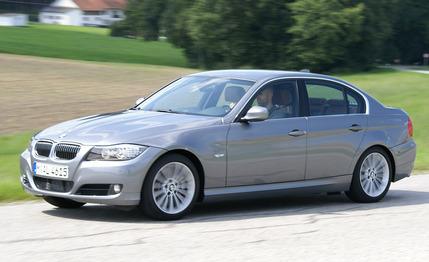
 First Drive Review
First Drive Review
Powerful and aggressive, compact sports sedans offer all the car you need if the focus is on the driving experience instead of pampering passengers. And ever since the segment’s ancient progenitor, the 2002, BMW’s small sedans have virtually defined the genre. Today’s 3-series is still the car that everyone else tries to emulate, but facing an onslaught of competition from a sportier Mercedes C-class, a more Germanic Lexus IS, and a strongly improved Audi A4, the BMW 3-series actually needs to fight to retain its position.
A Significant Face Lift
This midterm face lift comes a bit early, and it is fairly extensive by BMW’s standards. Clearly visible changes include a new front bumper with friendlier-looking lower air intakes. The front grille loses its effeminate eyebrows, and the hood gains two pronounced creases, similar to those on the now-departed Z4 M versions. The front lighting units are accentuated with LED turn signals encased in a cool-looking grid. The taillights offer a similar effect, and their outer shapes have been altered to match those of the 3-series coupe. The headlights regrettably keep their odd shape, despite the M3 sedan having demonstrated that the coupe’s simpler headlights work perfectly with the four-door body. Wider aluminum wheels accentuate the car’s width, and a new side-view-mirror design apes the two creases on the front hood.
Inside the 3-series, the shapes and the controls are mostly carried over, but the materials are upgraded to alleviate the somewhat stark overall appearance. The iDrive system has gone through another round of simplifications. The navigation menu looks suspiciously similar to that of Audi’s MMI system; a few useful buttons let you bypass the system. We don’t exactly love it now, but it’s user-friendly enough not to make you run anymore. You can still skip iDrive altogether by not ordering a factory-installed navigation system.
New-for-U.S. Monster Diesel, Other U.S. Engines Unchanged
Engines remain unchanged, with the exception of the second most powerful diesel, the 330d. We tested this formidable 242-hp powerplant coupled with a six-speed manual. The 330d performed extremely well, pulling strongly enough—even above 130 mph—to make sports-car drivers weep. Unfortunately, it won’t come to the U.S., but that’s okay. We’ll get the 335d instead, positioned one notch above the 330d. It has an identical 3.0-liter displacement but adds two turbochargers and produces 265 horsepower and a fearsome 425 pound-feet of torque, the latter available as low as 1750 rpm. Compare that with the M3’s 295 pound-feet of torque, and you get a clue as to this diesel’s attraction. Just keep the windows closed: The interior is well isolated, but outside, you still get treated to a distant, unsexy memento of your father’s diesel-powered Oldsmobile.
On the other hand, you’ll want to roll down the windows as often as possible in the other twin-turbocharged 3-series—the 300-hp 335i, powered by a 3.0-liter gasoline inline-six producing 300 pound-feet of torque. We had driven the 335i before the face lift many, many times, and we’re happy to report that the car remains just as delightful in this newest iteration. This unchanged powertrain is exceedingly capable, with instant power on tap up to its 155-mph cutoff.